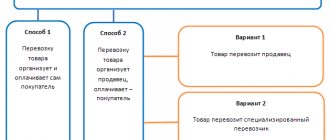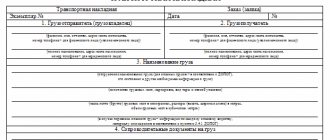Formula for calculating TRP for the remaining goods
Most companies use the methodology prescribed in Article 320 of the Tax Code of the Russian Federation. This formula for calculating TZR should apply exclusively to transportation costs. The remaining costs associated with the sale are written off in full. In this way, the company will be able to bring accounting and tax accounting at the enterprise as close as possible.
For the distribution of TZR, it would be fair to use the following calculation option:
K = (TP0 + TR1) / (T1 + T2) * 100%, where:
- K is the average percentage of transportation costs for the remaining goods at the end of the month;
- TP0 are those transportation costs that fall on the balance of unsold products at the beginning of the period;
- TP1 – transport costs incurred in the month under review;
- Т1 – purchase price of products sold in this period;
- T2 – the cost of purchasing products that remained unsold.
After which, transportation costs for the remaining goods are calculated by multiplying the indicators T2 and K.
Example . calculates transportation costs for the remaining goods. In April 2021, products were sold with a total cost of 800,000 rubles. Goods worth 200,000 rubles remained unsold. The balance of TRP at the beginning of the month was 25,000 rubles, and the total amount of TRP for April was 45,000 rubles. How to calculate the TRP for the balance in this case?
Let's use the previously given formula:
P = (25,000 + 45,000) / (800,000 + 200,000) * 100% = 7%. Therefore, transportation costs for the remainder will be: 200,000 * 0.07 = 1,400 rubles.
Moreover, the remaining expenses from last month and the expenses incurred, minus those that fall on the balance, can be written off as cost. That is, you first need to calculate the TZR for write-off: 25,000 + 45,000 – 1,400 = 68,600 rubles.
WE DISTRIBUTE TRANSPORT COSTS
As part of the expenses of the current reporting (tax) period, you will take into account only that part of transportation costs that is directly related to goods sold during this period.
The amount of transportation costs, which relates to the balance of unsold goods, must be determined by the average percentage for the current month, taking into account the carryover balance at the beginning of the month.
This must be done as follows (paragraph 3 of Article 320 of the Tax Code of the Russian Federation):
1) determine the amount of direct expenses attributable to the balance of unsold goods at the beginning of the month and incurred in the current month;
2) determine the cost of purchasing goods sold in the current month and the cost of purchasing the balance of unsold goods at the end of the month;
3) calculate the average percentage as the ratio of the amount of direct expenses (item 1) to the cost of goods (item 2);
4) determine the amount of direct expenses related to the balance of unsold goods as the product of the average percentage and the cost of the balance of goods at the end of the month.
Moreover, if an organization sells several types of goods, then the amount of transportation costs that relates to unsold goods is determined by the total balance of goods. Distribution of transport costs by type of goods Art. 320 of the Tax Code of the Russian Federation does not provide for it (Letter of the Ministry of Finance of Russia dated November 12, 2009 N 03-03-06/4/98).
EXAMPLE
Distribution of direct transport costs
Situation
On the 1st day of the reporting period, the Alpha organization records the balance of unsold goods in the amount of 1,500,000 rubles. Transportation costs related to the balance of goods amounted to RUB 90,000. During the reporting period, goods were purchased in the amount of 4,500,000 rubles, the cost of their delivery amounted to 250,000 rubles.
During the reporting period, goods worth 4,300,000 rubles were sold. According to the accounting policy, delivery costs are not included in the cost of goods and, according to supply contracts, they are not included in the price of the purchased goods.
Solution
Let's calculate the amount of transportation costs by which the Alpha organization can reduce the taxable profit of the reporting period.
1. We determine the amount of transportation costs that relates to the balance of goods not sold at the beginning of the reporting period and to goods purchased during this period - 340,000 rubles. (90,000 rub. + 250,000 rub.).
2. We determine the cost of goods sold and remaining unsold during the reporting period - 6,000,000 rubles. (4,300,000 rub. + (1,500,000 rub. + 4,500,000 rub. - 4,300,000 rub.)).
3. Find the average percentage - 5.67% (340,000 rubles / 6,000,000 rubles x 100%).
4. Determine the amount of transportation costs related to unsold goods. To do this, we multiply the average percentage (see point 3) by the cost of goods not sold at the end of the reporting period: 5.67% x (1,500,000 rubles + 4,500,000 rubles - 4,300,000 rubles) = 5.67 % x 1,700,000 rub. = 96,390 rub.
Consequently, the amount of transportation costs that the Alpha organization will take into account when calculating income tax for the reporting period will be 243,610 rubles. (90,000 rub. + 250,000 rub. - 96,390 rub.).
METHODS FOR ASSESSING THE COST OF PURCHASED GOODS
The cost of purchasing goods can be determined using one of the following methods:
— at the cost of the first acquisition (FIFO);
— at the cost of the most recent acquisition (LIFO);
- at average cost;
- at the cost of a unit of goods.
The chosen method must be fixed in your accounting policy.
The procedure for applying methods for assessing goods is not disclosed in the Tax Code of the Russian Federation. However, these methods are similar to the valuation methods used in accounting. Their description is contained in paragraphs 73 - 77 of the Methodological guidelines for accounting of inventories, approved by Order of the Ministry of Finance of Russia dated December 28, 2001 N 119n.
Note!
Organizations could use the LIFO method in accounting only until January 1, 2008 (see.
How to calculate TZR based on materials?
Transport costs of an enterprise may be associated with the purchase of not only finished goods, but also materials that are subsequently used in production. In this case, it is necessary to correctly distribute the incurred TRP. This can be done in several ways in accordance with PBU 5/01:
- using account 15 (TZR is written off against the procurement and purchase of materials);
- using a separate sub-account for goods and materials on account 10 “Materials”;
- by directly including the incurred TRP in the cost of materials.
The last option allows you to minimize calculations. And in the first two cases, how to calculate the TZR? The formula for write-off is specified in the Methodological Instructions for Deviations or TZR (clause 87). The calculation must be made as follows:
K = (Off0 + Off1) / (M0 + M1) * 100%, where:
- K – percentage of write-off of equipment;
- Off0 – the amount of remaining TZR at the beginning of the period;
- Off1 – the amount of TZR incurred in the month under review;
- M0 – remaining materials at the beginning of the month;
- M1 – the amount of materials purchased per month.
Moreover, the cost of materials is taken as indicated in the accounting documents. After that, the TRP for materials is calculated by multiplying the resulting percentage by the accounting cost of the materials written off as production costs.
Cost calculation
According to Article 320 of the Tax Code, the amount of direct expenses in terms of transportation costs is determined by the average percentage for the current month, taking into account the carryover balance at the beginning of the month.
According to Article 320 of the Tax Code, the amount of direct expenses in terms of transportation costs is determined by the average percentage for the current month, taking into account the carryover balance at the beginning of the month. For this:
- the amount of direct expenses attributable to the balance of unsold goods at the beginning of the month and incurred in the current month is determined;
- the cost of purchased goods sold in the current month and the cost of the balance of unsold goods are determined;
- the average percentage is calculated as the ratio of the amount of direct costs to the cost of goods;
- The amount of direct expenses related to the balance of unsold goods is determined as the product of the average percentage and the cost of the balance of products at the end of the month.
At the same time, the amount of direct expenses related to the balance of unsold goods, according to the Ministry of Finance, should include all products owned by the company, including those in transit, as well as those shipped before the transfer of rights to buyers (Letter of the Ministry of Finance of the Russian Federation dated 03.06. 2008 No. 03-03-09/70).
How to calculate TZR for cargo delivery?
Often, enterprises are forced to deliver cargo themselves or pay for this service to the supplier. As a result, their final cost increases. In this regard, there is a need to calculate transport costs for cargo delivery.
Not all enterprises are ready to calculate and take into account the technical requirements for each batch - this requires a lot of time, and in such calculations one can easily make a mistake. In this regard, some organizations determine transport tariffs depending on the distance of transportation. This allows you to quickly make calculations. Some even use the state tariff system.
In this case, it is possible to calculate transportation and procurement costs more accurately by determining the cost of delivering 1 ton of cargo per 1 km of route.
Similar articles
- General production costs: calculation formula
- Nuances of postings debit 10 credit 10
- Transportation and procurement costs
- Accounting for transport costs
- Accounting for transport costs in the estimate
Calculation of transport costs - formula
In addition, we deliver urgent express shipments in 1 day to many cities in Russia: Moscow, St. Petersburg, Nizhny Novgorod, Novosibirsk, Perm, Rostov-on-Don, Krasnodar, Yekaterinburg, Samara, Ufa, Kazan and others. There are various delivery options at your service: express light warehouse-warehouse, express light warehouse-door, express light door-warehouse, express light door-door, SUPER express and BLITZ express. And also a new tariff for individuals, with payment by the sender - Parcel. You can also call the courier to pick up your shipment by calling toll-free 8-800-250-04-05.
To place a calculator on your website, use a simple online constructor www.kit.cdek-calc.ru
How to place a calculator on your website
SDEKO website SDEKO offices Track your order
2016 - 2021 Courier company SDEKHotline: 8 800 250-04-05
The fourth goal of logistics is to achieve consolidation of transportation volumes.
Transportation costs are a combined major logistics expense, representing almost 58% of total costs. In general, shipping costs increase depending on the distance, the size of the shipment, and the susceptibility of the product to damage. Transport costs per unit weight decrease as lot size increases over long runs. Many logistics systems are designed to use high-speed, reliable vehicles in order to achieve high-quality service, albeit at enormous cost. Maximum consolidation of transportation volumes can help reduce transportation costs. Consolidation can be achieved by combining small lots into one large one intended for a long run (i.e., long distance). A shipment of goods sent over a long distance is then broken up to deliver the goods to each individual customer. While there are always costs associated with local distribution, there are still significant cost savings associated with consolidated long haul transportation. Maximum consolidation requires cooperation in order to group small quantities of goods. Such cooperation must fit within the framework of the overall value chain. [p.562] All estimates take into account transportation costs. The methodology for calculating costs in estimates No. 1, 2, 3 is approximately the same. The amount of direct costs is obtained by multiplying the cost of a unit of work, i.e., the prices of the corresponding section of the price list, with the addition of transportation costs for the volume of work. Data on the physical volumes of work and their characteristics are taken according to the technical design, prices are taken according to the Price List of regional prices for the construction of oil and gas wells, and transportation costs are calculated based on the cost of transporting 1 ton of materials to the required distance and the weight of these materials per unit of work . [p.320] The first, most important factor is related to the presence of transport costs, which creates natural barriers to trade. The smaller the share of transportation costs in total production costs, the more likely it is that a given product will be sold on world markets. Products with a very high value per unit weight, and therefore with low unit transport costs, are most likely to be exported. The main example of such a commodity is gold, its price is almost the same in all major world markets. In another extreme case, hairdressing services in New York will cost $25, but in Delhi only $5. High transportation costs make these services non-exportable. Many types of services, although not all, are characterized by high levels of transport costs per unit of service offered. Technological advances in communications have created a global market for a range of financial services, including banking and insurance. Indeed, exports of services from developing countries have been growing rapidly recently, especially in areas such as data processing, design work, software development, and tourism. For example, workers in Jamaica, Manila and South Korea are engaged in entering information into the computer networks of the largest multinational companies located in the United States. [p.716]
Distribution of transportation costs is carried out in two stages. First, costs are allocated to workshops in proportion to the weight of materials delivered and finished products shipped (tons). Secondly, they are included in the unit cost of production based on the number of items produced. [p.304]
The incorrectness here is that the inclusion of the planned value of transport costs in the accounting price distorts the factor analysis, since the actual transport costs per unit of purchases depend on the dynamics of the physical volume of purchases (for example, the consumption of fuel and other fuels and lubricants can be determined by the ton-kilometer of transported goods , that is, it depends on deviations in the procurement structure (depending on the weight of transported MPAs) and the distance to the supplier), while deviations in the invoice price are determined by the market conditions of material working resources. In other words, the cumulative deviation of the discount price will consist of two components that have completely different economic conditions. This can be illustrated mathematically as follows [p.121]
You should be very careful when setting prices for a foreign buyer. The contract may include items such as credit conditions, specifying the parties responsible for the goods in transit and obligated to pay insurance and transportation costs (indicating the specific point of departure/arrival). As noted, the profitability of a business can be greatly influenced by the currency in which payments are made. This issue should also be discussed in the contract. Finally, it must certainly indicate the quality and quantity of the goods. If necessary, it is also necessary to specify in what units the weight of the goods is measured, for example, in metric or English tons. To minimize potential future disputes regarding product returns due to defects, the contract should agree on what quality standards will be used to evaluate the shipment. Thus, depending on the factors listed above, the final sales prices for the same product in different countries may differ significantly from each other. [p.643]
The cost of transportation is reduced when vehicles operate with trailers. This is explained by the fact that the increase in variable costs per 1 km of run and constant costs per 1 hour of work occurs disproportionately to the increase in the productivity of rolling stock. Due to the lighter weight of the trailer compared to the car, the consumption of fuel, lubricants, deductions for the restoration and repair of car tires per 1 t-km are reduced. A lower trailer price reduces depreciation charges by 1 t-km. The use of trailers also ensures a reduction in fuel consumption per unit of transport products at [p.241]
In the process of analysis, the composition and level of costs for operating construction machines and vehicles are studied in order to identify opportunities to reduce construction costs. The costs of mechanization have a small share in the cost of construction and installation work - from 3 to 10%, but the effective use of construction machines leads to a reduction in the cost of manual labor and this helps to reduce the cost and speed up construction. Therefore, data are considered that characterize not only operating costs per machine shift or unit of machine work, but also the use of the machine fleet. The necessary data for analysis is taken from the report on the mechanization of construction and the use of construction machines and from the report on the cost of construction and installation work. In relation to the use of vehicles, opportunities are being identified to reduce transport distances, eliminate empty runs, and also reduce the volume of land transport through more economical planning solutions. The synthetic indicator used in the analysis of transportation costs in construction is the volume of transportation in t-km per 1 million rubles. construction and installation works. Actual data on the volume of traffic is contained in the transport performance reports. They are compared with the corresponding data from the design documentation and construction and financial plan. [p.60]
In fact, chemical production is characterized by a wide variety of products produced, differing from each other in their physical properties (volume and bulk weight, state of aggregation, product losses due to long storage, etc.), which greatly influence the amount of transport costs when they are used. transportation (incomplete loading of wagons, the need to use special containers for certain types of products, the use of ordinary and special tanks suitable only for certain liquid chemicals, etc.). The production of chemical products is characterized by the use of a wide variety of raw materials, which have large differences in the costs of their transportation, as well as varying consumption rates per unit of finished product over large ranges. Different amounts of fuel are consumed to obtain certain types of products. Finally, chemical production is characterized by the release of by-products and a wide variety of waste. [p.21]
In the context of technical progress in the production of mineral fertilizers, the specific gravity of the useful substance per unit weight increases, which gives a great economic effect due to reduced transport costs. But calculating the cost of mineral fertilizers cannot be done in isolation from the economic interest of enterprises in the production of high-quality fertilizers and in expanding the production of fertilizers containing more substances beneficial to plants. Experience shows that the nutrient content in fats obtained from the same type of raw material using the same technological schemes varies within quite significant limits. In this regard, enterprises need to compare possible additional costs for improving quality with revenue for these products, which necessitates calculating the cost of mineral fertilizers taking into account the content of useful substances. [p.205]
In different industries O. r. p.p. is different and develops under the influence of unique specific conditions. The oud plays the main role here. weight of transportation costs in the cost of production. It is determined by 3 main points: the amount of material required to produce a unit of product, the weight of transported materials per unit of their cost, the distance of transportation, depending on the territorial location of sources of raw materials and centers of consumption of products. These factors determine comparative economics. the expediency of greater or lesser concentration of production, and therefore O. r. p.n. in each specific case. [p.114]
Along with improving the design of parts and products, electrical engineering is achieved by creating new and improving the quality of materials used, choosing them correctly, carefully preparing for production and consumption, through the introduction of new equipment, rationalization of technology. processes, increasing the material interest of workers in electrical energy. The ways of electrical engineering are usually divided into constructive and technological. The first result is a reduction in the weight of machines and mechanisms while simultaneously increasing their quality. Reducing the weight of machines and products ensures savings in metal and other materials, reduction in the size of equipment, and reduction in the labor intensity of their manufacture. Of particular importance is reducing the weight of transport vehicles - cars, locomobiles, tractors, etc., since it reduces energy consumption for their movement and increases their carrying capacity. In the USSR, the weight of cranes, ammonia compressors, excavators, machine tools, etc. has been reduced. However, the possibilities of reducing the weight of machines while improving their performance have not been exhausted. The weight of many similar machines of the same power, manufactured by different factories, often differs by 15-20%. Some owls machines are heavier in weight than similar capitalist machines. firms There are abs. machine weight and relative, i.e. weight per unit of power, load capacity, productivity. Basic ways to reduce the weight of machines and products, elimination of excessive safety margins when calculating parts and assemblies, revision of designs in terms of simplifying their design, concentration of power in one unit, use of modified and high-strength cast irons, as well as low-alloy steels, lightweight bent and hollow sections, introduction of welded structures, use methods of surface hardening of parts, etc. [p.438]
COST OF TRANSPORTATION - operating costs of transport organizations per unit of transportation (1 t-km, 1 passenger-km). In industrial production, compared to the cost of industrial products, there are no costs for raw materials; the share of depreciation charges is higher (20-28%) and wages (in railway transport - about 48%, in automobile transport - 38- 40, water - 34-36, air - 35%). On the railway In transport, more than 85% of all expenses are the costs of transportation and repair of fixed assets. Comparison of planned and actual. costs are carried out on the basis of calculation sheets, which reflect the cost of cargo and passengers on average for the entire railway. transport and on each road from passenger transportation, the costs of transporting baggage and mail are separately allocated. The cost of cargo is calculated per ton-km of net tariff mileage, which depends on the distance between the point of departure and the point of destination. In 1962, the cost of 10 t-km was 2.67 kopecks, and 10 passenger-km - 5.88 kopecks, i.e., respectively 45% and 26% lower than the cost of 1950. In addition, C n is calculated per given t-km, in order to determine the number of which net t-km of freight traffic and passenger-km are summed up. In 1962, the cost of 10 given t-km was slightly more than 3 kopecks, or 43 % below 1950. The cost of freight transportation is calculated separately for types of traction: electric wave, diesel locomotive and steam locomotive, and for passenger transportation - in diesel trains and motor-car sections. By 1965, 85-87% of all transportation will be carried out by electric train. and diesel traction as a result by 30-40% [p.331]
As a rule, the greater the weight of the shipment, the lower the cost of transporting a unit of cargo to its destination. Railroad and trucking companies usually provide discounts for heavy freight shipments. So, other things being equal, enterprises benefit from supply sizes that provide savings in transportation costs. These delivery quantities may exceed the economic order quantity calculated using the EOQ (e onomi order quantity) model. An increase in the size of the supply has a double effect on the cost of holding inventory: the first consequence of a larger supply is the volume of average current 94 [p.94]
A significant part of the materials consumed by the building are complementary, that is, they are used only in a certain quantitative combination. Industrialization of the country, associated with an increase in the beat. the weight of the prefabricated building, reinforces the importance of the completeness of the supply of construction organizations with both basic and auxiliary materials. Due to the relative duration of construction of buildings and structures, the range of required materials at different stages of the construction cycle is subject to significant changes. Therefore, when planning M.-t. With. With. O. it is necessary to take into account both the changing composition of objects under construction and the degree of their readiness. When constructing objects with a duration of St. 1 year plan to depreciate them. material resources should be established for the entire period of construction. At the same time, taking into account the growing volume and importance of construction reserves (see Backlog), it is necessary to provide in terms of material and technical. supplies and their proper provision. To calculate the need for materials on a building, they are used when compiling national economics. plans are averaged standards (per 1 million rubles of the estimated cost of construction and installation work). When calculating the need for materials for individual construction organizations, they use estimated standards for the consumption of materials for various physical units. volume of work (see Rate of consumption of materials in construction). The supply plans also provide for the needs of auxiliary enterprises and production of construction organizations allocated to an independent balance. Due to the territorial dispersion and large extent of many construction works (especially on the construction of roads, main pipelines, communication lines), each of the geographically distant construction divisions should be provided with materials. The delivery of materials must be organized directly to construction sites, which has a positive impact on the organization of warehouse storage. Elimination of unproductive costs for setting up on-site warehouses, unloading and storing materials and parts is achieved by using the installation of buildings directly from vehicles. This method requires assigning a complete supply of construction parts to individual plants [p.425]
S.-f. R. for the purchase, delivery and installation of equipment is compiled by type of equipment (technological, hoisting and transport, energy, etc.) and installation work, based on price lists for equipment and aggregated indicators or installation cost standards, and in their absence - by price tags for installation. For each type of equipment, its quantity and weight, the price of a unit of equipment and the price for installation, the total estimated cost of equipment and installation work, transportation and procurement and storage costs, salary deviations and the cost of materials not included in the price tags for installation are indicated. [p.33]
Calculation of transport costs per unit of goods
Good afternoon Please tell me how to correctly calculate transport costs per unit of goods. I think like this: Given: batch of goods A - 4 pieces for 1822 rubles B - 2 pieces for 1496 rubles C - 4 pieces for 5814 rubles D - 2 pieces for 1176 rubles D - 3 pieces for 1552 rubles E - 2 pieces for 5614 rubles G - 9 pieces for 331 RUB Total delivery amount - 54,751.00 RUB Delivery cost - 3,845.00 RUB I derive the cost coefficient: 3845.00/54751 = 0.07022703, which is applicable to any product from this batch. Let's say an invoice is issued to the buyer for A-1pcs + B- 1 piece + G-1 piece + F-1 piece After payment, I write off the cost of the goods on the invoice - (1822+5814+1176+331) = 9143 rubles, transportation costs 9143 * 0.07022703 = 642.09 rubles. O. KUDiR reflects 9143 rubles - write-off of the cost of goods and 642.09 rubles write-off of transport costs. The formula for calculating transport costs per unit of goods: Delivery cost / cost of a batch of goods * cost of a unit of goods. This calculation method is indicated here. Link removed by moderator. Placing links and hyperlinks to other media and commercial sites without the consent of the portal administration is prohibited by the forum rules. I saw another method online. The costs of paying for the consignment of goods and transportation costs are summed up: 54,751 + 3845 = 58,596 rubles. This amount is taken as 100%. Next, the share of transport costs is calculated as 3845 / 58596 * 100% = 6.56% From here, if a product is sold with a total cost of 9143 rubles, then transport costs will be 9143/100 * 6.56 = 599.78 rubles. This method is indicated here: Link removed by moderator. Placing links and hyperlinks to other media and commercial sites without the consent of the portal administration is prohibited by the forum rules. These methods give different results. Which one is correct if transport costs are included in the price of the product? Thank you.
Tags: accountant, personnel, capital, coefficient, credit, tax, order, expense, write-off, formula






